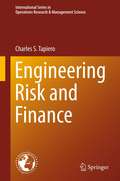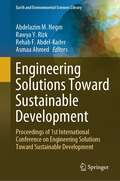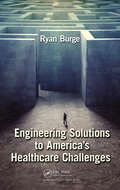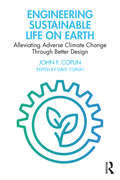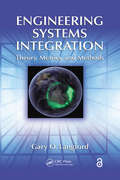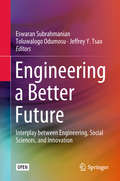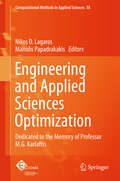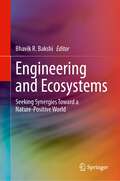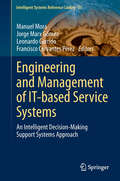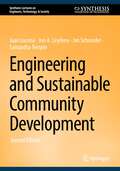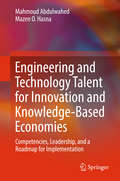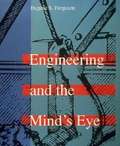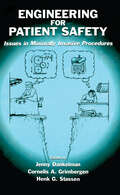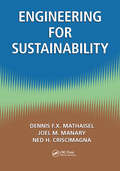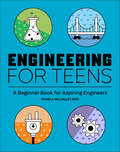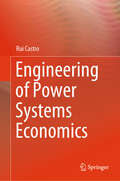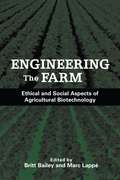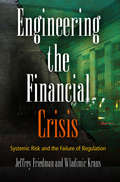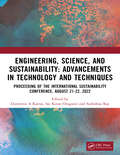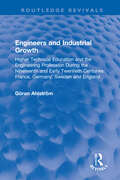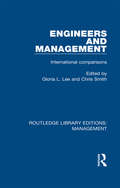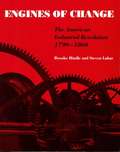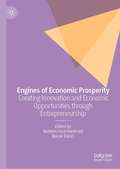- Table View
- List View
Engineering Risk and Finance
by Charles S. TapieroRisk models are models of uncertainty, engineered for some purposes. They are "educated guesses and hypotheses" assessed and valued in terms of well-defined future states and their consequences. They are engineered to predict, to manage countable and accountable futures and to provide a frame of reference within which we may believe that "uncertainty is tamed". Quantitative-statistical tools are used to reconcile our information, experience and other knowledge with hypotheses that both serve as the foundation of risk models and also value and price risk. Risk models are therefore common to most professions, each with its own methods and techniques based on their needs, experience and a wisdom accrued over long periods of time. This book provides a broad and interdisciplinary foundation to engineering risks and to their financial valuation and pricing. Risk models applied in industry and business, heath care, safety, the environment and regulation are used to highlight their variety while financial valuation techniques are used to assess their financial consequences. This book is technically accessible to all readers and students with a basic background in probability and statistics (with 3 chapters devoted to introduce their elements). Principles of risk measurement, valuation and financial pricing as well as the economics of uncertainty are outlined in 5 chapters with numerous examples and applications. New results, extending classical models such as the CCAPM are presented providing insights to assess the risks and their price in an interconnected, dependent and strategic economic environment. In an environment departing from the fundamental assumptions we make regarding financial markets, the book provides a strategic/game-like approach to assess the risk and the opportunities that such an environment implies. To control these risks, a strategic-control approach is developed that recognizes that many risks resulting by "what we do" as well as "what others do". In particular we address the strategic and statistical control of compliance in large financial institutions confronted increasingly with a complex and far more extensive regulation.
Engineering Solutions Toward Sustainable Development: Proceedings of 1st International Conference on Engineering Solutions Toward Sustainable Development (Earth and Environmental Sciences Library)
by Abdelazim M. Negm Rawya Y. Rizk Rehab F. Abdel-Kader Asmaa AhmedThis book constitutes the referred proceeding of the 1st International Conference on Engineering Solutions Toward Sustainable development (ESSD2023), organized by the Faculty of Engineering, Port Said University and held in Port Said, Egypt, during May 2-3, 2023. The book is devoted to fulfill the need for sustainable development that has never been more urgent. It shows the crucial role of engineering to play in this transition from consumption culture to responsible culture. This book explores the relationship between engineering and sustainability, highlighting the vital role that engineering plays in achieving sustainable development. The book provides a comprehensive guide for engineers, researchers, and experts from different disciplines that are interested in sustainable development. From renewable energy sources to green infrastructure, the book delves into the latest technological advancements providing insights and practical strategies for designing and implementing sustainable solutions. With practical examples and case studies, readers will gain a deep understanding of how engineering principles and practices can be harnessed to develop sustainable solutions that balance economic, social, and environmental needs and to mitigate the negative impacts of human activity on our planet. The books is very useful for graduate students, researchers, policy planners, decision makers and stakeholders in the field of renewable energy, clean water development, climate actions, smart cities and communities and green infrastructures.
Engineering Solutions to America's Healthcare Challenges
by Ryan BurgeEngineering Solutions to America‘s Healthcare Challenges covers the technologies, systems, and processes that are emerging in hospitals, clinics, community centers, universities, and the White House to repair healthcare in the United States. Focusing on the importance of individuals being proactive about their own state of health, it presents a sys
Engineering Sustainable Life on Earth: Alleviating Adverse Climate Change Through Better Design
by John F. CoplinClimate scientists have clarified the main causes of climate change, and the tight timescale within which humans must change behaviour, and implement effective solutions, wherever they are needed across the world. This book uncovers many of the powerful actions and uses them effectively to achieve sustainable human life, of improved quality, in a way that is affordable out of earned income for all humans, wherever they live. The ultimate solution to climate change lies not just in doing and consuming less but does instead entirely revolve around our ability to "out innovate" the problem. John F. Coplin, CBE, FREng, FCGI, has had a long and distinguished career in engineering and has operated and advised at all levels from heads of state, company chairs, engineering directors, government advisory boards, and on the shop floor. He is perfectly placed to take a wide-ranging approach, applying modern design and innovative engineering at a systemic level in order to provide novel approaches that will have far-reaching impact on reversing humankind’s impact on this planet. His projections and solutions are based on facts, reasonable calculations, and science learnt from nature. Unafraid to challenge current thinking, John looks at solutions across multiple sectors, including aviation, cars and domestic local transport, clean and renewable energy, food and agriculture, and housing and communities, and describes the particular potential of hydrogen as fuel. The book is written in a language for all. It is small enough to be used is a practical guide to where some of the most useful improvements are to be found and as a way to start important conversations.
Engineering Systems Integration: Theory, Metrics, and Methods
by Gary O. LangfordThe first book to address the underlying premises of systems integration and how to exposit them into a practical and productive manner, this book prepares systems managers and systems engineers to consider their decisions in light of systems integration metrics. The book addresses two questions: Is there a way to express the interplay of human actions and the result of system interactions of a product with its environment, and are there methods that combine to improve the integration of systems? The systems integration theory and integration frameworks proposed in the book tie General Systems Theory with practice.
Engineering a Better Future: Interplay between Engineering, Social Sciences, and Innovation
by Eswaran Subrahmanian Toluwalogo Odumosu Jeffrey Y. TsaoThis open access book examines how the social sciences can be integrated into the praxis of engineering and science, presenting unique perspectives on the interplay between engineering and social science. Motivated by the report by the Commission on Humanities and Social Sciences of the American Association of Arts and Sciences, which emphasizes the importance of social sciences and Humanities in technical fields, the essays and papers collected in this book were presented at the NSF-funded workshop ‘Engineering a Better Future: Interplay between Engineering, Social Sciences and Innovation’, which brought together a singular collection of people, topics and disciplines. The book is split into three parts: A. Meeting at the Middle: Challenges to educating at the boundaries covers experiments in combining engineering education and the social sciences; B. Engineers Shaping Human Affairs: Investigating the interaction between social sciences and engineering, including the cult of innovation, politics of engineering, engineering design and future of societies; and C. Engineering the Engineers: Investigates thinking about design with papers on the art and science of science and engineering practice.
Engineering and Applied Sciences Optimization
by Manolis Papadrakakis Nikos D. LagarosThe chapters which appear in this volume are selected studies presented at the First International Conference on Engineering and Applied Sciences Optimization (OPT-i), Kos, Greece, 4-6 June 2014 and works written by friends, former colleagues and students of the late Professor M. G. Karlaftis; all in the area of optimization that he loved and published so much in himself. The subject areas represented here range from structural optimization, logistics, transportation, traffic and telecommunication networks to operational research, metaheuristics, multidisciplinary and multiphysics design optimization, etc. This volume is dedicated to the life and the memory of Professor Matthew G. Karlaftis, who passed away a few hours before he was to give the opening speech at OPT-i. All contributions reflect the warmth and genuine friendship which he enjoyed from his associates and show how much his scientific contribution has been appreciated. He will be greatly missed and it is hoped that this volume will be received as a suitable memorial to his life and achievements.
Engineering and Ecosystems: Seeking Synergies Toward a Nature-Positive World
by Bhavik R. BakshiThis book demonstrates how the inclusion of nature in engineering decisions results in innovative solutions that are economically feasible, ecologically viable, and socially desirable. It advances progress toward nature-positive decisions by protection and restoration of ecosystems and respect for ecological boundaries. The topic of this book is an active area of academic research, and leading companies are including goals associated with ecosystem services in their sustainability plans. This book is the first collection of methods and applications that explicitly include the role of nature in supporting engineering activities and describes the role that ecosystems play in supporting technology and industry. It describes approaches, models, applications, and challenges for innovation and sustainability that will be useful to students and practitioners.
Engineering and Management of IT-based Service Systems
by Jorge Marx Gómez Manuel Mora Leonardo Garrido Francisco Cervantes PérezIntelligent Decision-Making Support Systems (i-DMSS) are specialized IT-based systems that support some or several phases of the individual, team, organizational or inter-organizational decision making process by deploying some or several intelligent mechanisms. This book pursues the following academic aims: (i) generate a compendium of quality theoretical and applied contributions in Intelligent Decision-Making Support Systems (i-DMSS) for engineering and management IT-based service systems (ITSS); (ii) diffuse scarce knowledge about foundations, architectures and effective and efficient methods and strategies for successfully planning, designing, building, operating, and evaluating i-DMSS for ITSS, and (iii) create an awareness of, and a bridge between ITSS and i-DMSS academicians and practitioners in the current complex and dynamic engineering and management ITSS organizational. The book presents a collection of 11 chapters referring to relevant topics for both IT service systems and i-DMSS including: problems of selection of IT service providers, optimization of supply chain systems, IT governance decisions, clinical decision support, dynamic user-interface adaptation, re-engineering of processes, and generic decision problems. Advanced IT technologies used in some chapters are: fuzzy multi-criteria mechanisms, semantic processing, data mining processing, and rough sets. Other chapters report traditional DSS mechanisms but used or suggested to be used in innovative mode for IT service engineering and management tasks.
Engineering and Product Development Management: The Holistic Approach
by Stephen C. ArmstrongThis practical guide to the components of engineering management employs a holistic approach. It will help engineers and managers understand how to improve the product development process by deploying new technology and new methods of working in concurrent teams. The book integrates elements from six well-known and understood bodies of knowledge: integrated product development, project management, process management, systems engineering, product data management, and organizational change management. These elements are framed within an overall enterprise-wide architecture. The techniques discussed work for both huge multinational organizations and smaller enterprises. The emphasis throughout is on practical tools for engineers, managers, and consultants responsible for project and product development.
Engineering and Sustainable Community Development (Synthesis Lectures on Engineers, Technology, & Society)
by Jen Schneider Juan Lucena Jon A. Leydens Samantha TempleThis book presents an overview of engineering as it relates to humanitarian engineering, service-learning engineering, peace engineering, or engineering for community-led development, programs that are often grouped under Engineering for Good or Engineering for Change. By placing “community” at the center of these endeavors, this book invites readers and practitioners to strive for sustainable community development (SCD). This 2nd edition is centered on new concepts of community-led development and includes topics on the history of engineers and development, the problems of using industry-based practices when designing for communities, how engineers can prepare to work with communities, and listening in community development. Two case studies are provided to highlight the book’s concepts using first-hand experiences of engineers engaged with communities—one of engineers developing a windmill for a community in India, and a second of an engineer mapping communities in Honduras for improved water management. The book concludes with student perspectives and experiences from a curricular model focused on engineering for sustainable community development. Overall, the text invites engineers to reflect and prepare themselves for global careers that involve international development in both the for-profit and non-profit sectors. This 2nd edition places community-led practices at the heart of these endeavors. The book is for engineering faculty, students and practicing engineers, involved in current or future community collaborations. The authors wrote this book with a goal to help readers critically reflect on their own practices and perceptions. Readers learn to question past, current, and future frameworks in the project of development, and are encouraged to adopt practices of community-led development. This 2nd edition is aimed at engineering students who, as future global engineers, are faced with opportunities and challenges when working with communities. As funding for renewable energy, “green jobs,” and community-based initiatives continue to increase, engineers will need to rely on the social and historical concepts presented in this book.
Engineering and Technology Talent for Innovation and Knowledge-Based Economies: Competencies, Leadership, and a Roadmap for Implementation
by Mahmoud Abdulwahed Mazen O. HasnaThis book introduces and analyzes the models for engineering leadership and competency skills, as well as frameworks for industry-academia collaboration and is appropriate for students, researchers, and professionals interested in continuous professional development. The authors look at the organizational structures of engineering education in knowledge-based economies and examine the role of innovation and how it is encouraged in schools. It also provides a methodological framework and toolkit for investigating the needs of engineering and technology skills in national contexts. A detailed empirical case study is included that examines the leadership competencies that are needed in knowledge-based economies and how one university encourages these in their program. The book concludes with conceptual modeling and proposals of specific organizational structures for implementation in engineering schools, in order to enable the development of necessary skills for future engineering graduates.
Engineering and the Mind's Eye
by Eugene S. FergusonIn this insightful and incisive essay, Eugene Ferguson demonstrates that good engineering is as much a matter of intuition and nonverbal thinking as of equations and computation. He argues that a system of engineering education that ignores nonverbal thinking will produce engineers who are dangerously ignorant of the many ways in which the real world differs from the mathematical models constructed in academic minds.
Engineering for Patient Safety: Issues in Minimally Invasive Procedures (Human Error and Safety)
by Jenny Dankelman Henk G. Stassen Comelis A. GrimbergenThis is a brief study of how human factors engineers have worked with medical personnel to improve patient safety and reduce medical error in the newest minimally invasive surgical procedures (laparoscopy, angioplasty, colonoscopy, etc).
Engineering for Sustainability
by Dennis F.X. Mathaisel Joel M. Manary Ned H. CriscimagnaSustainability and sustainable development have become popular goals. They have also become wide-ranging terms that can be applied to any entity or enterprise on a local or a global scale for long time periods. As enterprises and systems become more complex and development a support costs increase, the question remains: how does one engineer an ent
Engineering for Teens: A Beginner Book for Aspiring Engineers
by Pamela McCauleyExplore engineering as a career with this introduction for ages 12 to 16The job of an engineer is to solve all sorts of complex challenges facing the world while improving our lives through creative, innovative ideas. This engineering book for teens gives you a look into what engineers do and how they drive society forward through math and science.From designing tablets and smartphones to reimagining the way we collect and store renewable energy, this engineering book for teens introduces you to the major engineering disciplines and their distinct specialties, famous engineers throughout history, and more.Engineering for Teens offers:Engineering fundamentals—Discover the four main branches of engineering and their different specialties.Inspired inventions—Get examples of the incredible things that engineers have created, like fuel cells and medicines.Inclusivity in engineering—Learn all about the diversity within the field of engineering.Discover the wonders of engineering and prepare yourself for a life of scientific discovery with this engineering book for teens.
Engineering of Power Systems Economics
by Rui CastroThis textbook is a comprehensive resource designed for university master's students on power systems, with a focus on engineering-related aspects. It covers all the fundamental principles of power systems economics.PhD students seeking to enhance their understanding of power systems economics from an engineering standpoint will also benefit from this book. It offers in-depth analysis and detailed insights into economic engineering aspects, presenting various models that are meticulously explained.Furthermore, practising engineers from all disciplines will find this book useful as it provides practical solutions to real-world engineering issues. Through worked examples and solved problems derived from existing installations, professionals can apply the knowledge gained in their everyday work. From a broader perspective, the book caters to the growing number of individuals interested in the economics of power systems, whether driven by professional obligations or self-education.What sets this book apart from existing literature is its unique approach, establishing a strong connection between economics and engineering. Unlike traditional texts that predominantly focus on economic theory, this book bridges the gap by offering practical applications within the power system context. The first part looks into classic economic theory, exploring subjects such as producers and consumers, market behavior, and general market structures, always with a clear connection to power systems. Numerous examples from the power system industry enrich the learning experience. In the second part, the theory presented in the first section is applied to power system-specific problems. These include an in-depth examination of different costs in power systems, regulation strategies, and the intricacies of electricity markets.Overall, this book provides a valuable resource for universitystudents, PhD candidates, and engineers alike, offering a unique blend of economic theory and engineering applications.
Engineering the Farm: The Social and Ethical Aspects of Agricultural Biotechnology
by Britt Bailey Marc LappeEngineering the Farm offers a wide-ranging examination of the social and ethical issues surrounding the production and consumption of genetically modified organisms (GMOs), with leading thinkers and activists taking a broad theoretical approach to the subject. Topics covered include: the historical roots of the anti-biotechnology movement ethical issues involved in introducing genetically altered crops questions of patenting and labeling the "precautionary principle" and its role in the regulation of GMOs effects of genetic modification on the world's food supply ecological concerns and impacts on traditional varieties of domesticated crops potential health effects of GMOsContributors argue that the scope, scale, and size of the present venture in crop modification is so vast and intensive that a thoroughgoing review of agricultural biotechnology must consider its global, moral, cultural, and ecological impacts as well as its effects on individual consumers. Throughout, they argue that more research is needed on genetically modified food and that consumers are entitled to specific information about how food products have been developed.Despite its increasing role in worldwide food production, little has been written about the broader social and ethical implications of GMOs. Engineering the Farm offers a unique approach to the subject for academics, activists, and policymakers involved with questions of environmental policy, ethics, agriculture, environmental health, and related fields.
Engineering the Financial Crisis
by Jeffrey Friedman Wladimir KrausThe financial crisis has been blamed on reckless bankers, irrational exuberance, government support of mortgages for the poor, financial deregulation, and expansionary monetary policy. Specialists in banking, however, tell a story with less emotional resonance but a better correspondence to the evidence: the crisis was sparked by the international regulatory accords on bank capital levels, the Basel Accords.In one of the first studies critically to examine the Basel Accords, Engineering the Financial Crisis reveals the crucial role that bank capital requirements and other government regulations played in the recent financial crisis. Jeffrey Friedman and Wladimir Kraus argue that by encouraging banks to invest in highly rated mortgage-backed bonds, the Basel Accords created an overconcentration of risk in the banking industry. In addition, accounting regulations required banks to reduce lending if the temporary market value of these bonds declined, as they did in 2007 and 2008 during the panic over subprime mortgage defaults.The book begins by assessing leading theories about the crisis--deregulation, bank compensation practices, excessive leverage, "too big to fail," and Fannie Mae and Freddie Mac--and, through careful evidentiary scrutiny, debunks much of the conventional wisdom about what went wrong. It then discusses the Basel Accords and how they contributed to systemic risk. Finally, it presents an analysis of social-science expertise and the fallibility of economists and regulators. Engagingly written, theoretically inventive, yet empirically grounded, Engineering the Financial Crisis is a timely examination of the unintended--and sometimes disastrous--effects of regulation on complex economies.
Engineering to Adapt: Proceedings of Engineering to Adapt 2023 Symposium and Industry Summit (Springer Proceedings in Energy)
by David S-K. Ting Ahmad Vasel-Be-HaghThis book collates important contributions from Engineering to Adapt (ETA2023). Eta, η, the 7th letter of the Greek alphabet, is scrupulously used to denote efficiency and this is what ETA2023 strives for. In context, efficiency, η, is about avoiding waste, may this be energy, time, money, or material, in accomplishing something useful. As such, ETA2023 aims at bringing experts and future leaders together to forge more efficient ways to engineer and live. In other words, ETA2023 strives to synergise and catalyse all stakeholders, enthusiasts, and experts from academia, industry, policy arenas, and the general public, to formulate novel ways to improve tomorrow.This symposium will disseminate recent progress and promote collaborations to maximize opportunities for innovative integrated solutions. Topics of interest include resource and energy efficiency, waste reduction, and eco-friendly agriculture, architecture, engineering, and living.
Engineering, Science, and Sustainability: Advancements in Technology and Techniques
by Dimitrios A Karras Sai Kiran Oruganti Sudeshna RayISC 2022 is dedicated to the Niti Aayog policies to promote sustainability through exchange of ideas emerging out of the academia. The ISC is an annual conference that is held in virtual mode until COVID restrictions on travel exist. The vision of the conference is to capacitate Academia with the necessary ideas that provide insights of the grassroot level development to various stakeholders of the Niti-Aayog policies. Towards this goal, the conference creates a conjunction of various stakeholders of Niti-Aayog policies that include- academic institutions, government bodies, policy makers and industry. The ISC organizers make concerted efforts to promote academic research that would technological, scientific, management & business practices, and insights into policy merits & disruptions. The framework of exchange of ideas is geared towards adoption of deep technologies, fundamental sciences & engineering, energy research, energy policies, advances in medicine & related case studies. This framework enables the round table discussions between the academia, industry and policy makers through its range of plenary and keynote speakers.
Engineers and Industrial Growth: Higher Technical Education and the Engineering Profession During the Nineteenth and Early Twentieth Centuries: France, Germany, Sweden and England (Routledge Revivals)
by Göran AhlströmUsing an economic-historical and comparative approach, this book, first published in 1982, studies the structure and development of the engineering profession in France, German, Sweden and England. Central issues include the number of engineers in a particular society, their education and fields of work after education, the social background of the engineer, their social standing, the role of the state in technical education, and the development and role of the engineering organisations in various respects. The study shows that in three of the four countries, engineers achieved professional status rapidly and became members of their country’s establishment. In the fourth, England, not only did properly qualified engineers enjoy a considerably lower social status, but in numbers they were far fewer than in other parts of Europe. The author discusses this inadequacy in terms of industrial output and development.
Engineers and Management: International Comparisons (Routledge Library Editions: Management #43)
by Gloria L. LeeOriginally published in 1992. In an increasingly competitive climate, well-trained, experienced management is vital for establishing the long term future of industry. In response to this need, the number of management training courses have been growing in recent years. However, there is a group of highly skilled professionals who are not always recognized for their management potential. Engineers, often viewed as nothing more than technicians, are a valuable but neglected human resource. Their expertise has helped to generate the recent organizational restructuring throughout the manufacturing industry. This study compares the situation of engineers in Britain with those in other countries. It analyzes the industrial cultures of countries that have developed along very different traditions such as Japan, Germany and Hungary as well as countries like Canada and the US where British traditions have prevailed but where the outcomes are different. Bringing together leading writers on management who have specialist knowledge of the engineering profession, it covers such issues as education, employment and labour relations to show how far engineers are undervalued in British culture. This book should be of interest to undergraduates, MBA students, academics and researchers in management, engineering, new technology, industrial sociology and organizational behaviour.
Engines of Change: The American Industrial Revolution 1790-1860
by Brooke Hindle Steven LubarTHE MATERIAL ASPECTS OF AMERICAN LIFE UNDERWENT GREAT CHANGE in the period from 1790 to 1860, a pattern of development often referred to as the American Industrial Revolution. At the center of this transformation was a series of technological developments that were directly associated with labor, management, and organizational change. This book's discussion begins with physical survivals of technologies of that era, most of them preserved in the Smithsonian Institution. The book, like the exhibition from which it is derived (also entitled Engines of Change), endeavors to look through these artifacts to gain an understanding of the Industrial Revolution that differs significantly from popular perceptions. Specific insights can be gained from three dimensional survivals and from two dimensional views that are neither available in written accounts nor communicable through words alone. The photographs, drawings, and maps included here are, consequently, more than mere illustrations, more than a pleasant way to underline the written text. Indeed, in some ways they constitute the book's primary message. At the same time, the most obvious message conveyed by artifacts and pictures is limited by its unavoidable specificity. It must always be placed in a larger and broader context. Occasionally, observers bring enough context with them to interpret the artifacts they see, but usually extended verbal explanation is required to make objects and pictures truly meaningful. That is the purpose of the text of this book- to provide the context, to look through the physical survivals to an enriched comprehension of the technology and related aspects of the American Industrial Revolution.
Engines of Economic Prosperity: Creating Innovation and Economic Opportunities through Entrepreneurship
by Meltem Ince-Yenilmez Burak DariciThis book considers the extent to which innovation and entrepreneurship are engines of economic prosperity. It brings together theorists and empiricists from diverse backgrounds to provides a comprehensive overview of the field of entrepreneurship, focusing specifically on entrepreneurial developments within Turkey and the surrounding regions and Europe. It looks at innovation, creativity, economic development and women’s empowerment. This book considers the for-profit and the not-for-profit sectors, and examines outcome metrics such as change, sustainability and employment, in addition to economic value. This book will inspire academics and students to better understand the origins, evolution and impact of new ideas, new organizations, and new industries, and the impact on the economy. This book offers an excellent foundation for investigating and questioning current entrepreneurial practices across developed economies. It will also provide the foundations for researching and evaluating new and existing approaches to emerging technologies. Additionally, the book will offer useful insights into the real world, and will appeal to academics in economics and business as well as those studying entrepreneurship on the international scene.
